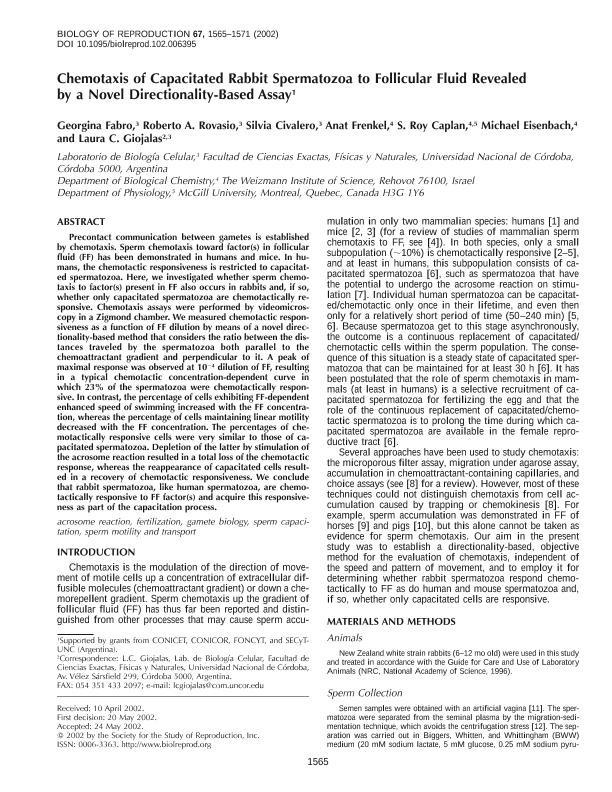Mostrar el registro sencillo del ítem
dc.contributor.author
Fabro, Georgina

dc.contributor.author
Rovasio, Roberto Americo

dc.contributor.author
Civalero, Silvia
dc.contributor.author
Frenkel, Anat
dc.contributor.author
Caplan, S. Roy
dc.contributor.author
Eisenbach, Michael
dc.contributor.author
Giojalas, Laura Cecilia

dc.date.available
2019-02-18T20:10:34Z
dc.date.issued
2002-11-01
dc.identifier.citation
Fabro, Georgina; Rovasio, Roberto Americo; Civalero, Silvia; Frenkel, Anat; Caplan, S. Roy; et al.; Chemotaxis of Capacitated Rabbit Spermatozoa to Follicular Fluid Revealed by a Novel Directionality-Based Assay; Society for the Study of Reproduction; Biology of Reproduction; 67; 5; 1-11-2002; 1565-1571
dc.identifier.issn
0006-3363
dc.identifier.uri
http://hdl.handle.net/11336/70397
dc.description.abstract
Precontact communication between gametes is established by chemotaxis. Sperm chemotaxis toward factor(s) in follicular fluid (FF) has been demonstrated in humans and mice. In humans, the chemotactic responsiveness is restricted to capacitated spermatozoa. Here, we investigated whether sperm chemotaxis to factor(s) present in FF also occurs in rabbits and, if so, whether only capacitated spermatozoa are chemotactically responsive. Chemotaxis assays were performed by videomicroscopy in a Zigmond chamber. We measured chemotactic responsiveness as a function of FF dilution by means of a novel directionality-based method that considers the ratio between the distances traveled by the spermatozoa both parallel to the chemoattractant gradient and perpendicular to it. A peak of maximal response was observed at 10-4 dilution of FF, resulting in a typical chemotactic concentration-dependent curve in which 23% of the spermatozoa were chemotactically responsive. In contrast, the percentage of cells exhibiting FF-dependent enhanced speed of swimming increased with the FF concentration, whereas the percentage of cells maintaining linear motility decreased with the FF concentration. The percentages of chemotactically responsive cells were very similar to those of capacitated spermatozoa. Depletion of the latter by stimulation of the acrosome reaction resulted in a total loss of the chemotactic response, whereas the reappearance of capacitated cells resulted in a recovery of chemotactic responsiveness. We conclude that rabbit spermatozoa, like human spermatozoa, are chemotactically responsive to FF factor(s) and acquire this responsiveness as part of the capacitation process.
dc.format
application/pdf
dc.language.iso
eng
dc.publisher
Society for the Study of Reproduction

dc.rights
info:eu-repo/semantics/openAccess
dc.rights.uri
https://creativecommons.org/licenses/by-nc-sa/2.5/ar/
dc.subject
Acrosome Reaction
dc.subject
Fertilization
dc.subject
Gamete Biology
dc.subject
Sperm Capacitation
dc.subject
Sperm Motility And Transport
dc.subject.classification
Otras Ciencias Biológicas

dc.subject.classification
Ciencias Biológicas

dc.subject.classification
CIENCIAS NATURALES Y EXACTAS

dc.title
Chemotaxis of Capacitated Rabbit Spermatozoa to Follicular Fluid Revealed by a Novel Directionality-Based Assay
dc.type
info:eu-repo/semantics/article
dc.type
info:ar-repo/semantics/artículo
dc.type
info:eu-repo/semantics/publishedVersion
dc.date.updated
2018-11-12T13:46:34Z
dc.identifier.eissn
1529-7268
dc.journal.volume
67
dc.journal.number
5
dc.journal.pagination
1565-1571
dc.journal.pais
Estados Unidos

dc.journal.ciudad
Madison
dc.description.fil
Fil: Fabro, Georgina. Consejo Nacional de Investigaciones Científicas y Técnicas. Centro Científico Tecnológico Conicet - Córdoba. Centro de Investigaciones en Química Biológica de Córdoba. Universidad Nacional de Córdoba. Facultad de Ciencias Químicas. Centro de Investigaciones en Química Biológica de Córdoba; Argentina. Universidad Nacional de Córdoba. Facultad de Ciencias Exactas, Físicas y Naturales. Centro de Biología Celular y Molecular; Argentina
dc.description.fil
Fil: Rovasio, Roberto Americo. Consejo Nacional de Investigaciones Científicas y Técnicas. Centro Científico Tecnológico Conicet - Córdoba. Instituto de Investigaciones Biológicas y Tecnológicas. Universidad Nacional de Córdoba. Facultad de Ciencias Exactas, Físicas y Naturales. Instituto de Investigaciones Biológicas y Tecnológicas; Argentina. Universidad Nacional de Córdoba. Facultad de Ciencias Exactas, Físicas y Naturales. Centro de Biología Celular y Molecular; Argentina
dc.description.fil
Fil: Civalero, Silvia. Universidad Nacional de Córdoba. Facultad de Ciencias Exactas, Físicas y Naturales. Centro de Biología Celular y Molecular; Argentina
dc.description.fil
Fil: Frenkel, Anat. Weizmann Institute of Science; Israel
dc.description.fil
Fil: Caplan, S. Roy. McGill University; Canadá. Weizmann Institute of Science; Israel
dc.description.fil
Fil: Eisenbach, Michael. Weizmann Institute of Science; Israel
dc.description.fil
Fil: Giojalas, Laura Cecilia. Consejo Nacional de Investigaciones Científicas y Técnicas. Centro Científico Tecnológico Conicet - Córdoba. Instituto de Investigaciones Biológicas y Tecnológicas. Universidad Nacional de Córdoba. Facultad de Ciencias Exactas, Físicas y Naturales. Instituto de Investigaciones Biológicas y Tecnológicas; Argentina. Universidad Nacional de Córdoba. Facultad de Ciencias Exactas, Físicas y Naturales. Centro de Biología Celular y Molecular; Argentina
dc.journal.title
Biology of Reproduction

dc.relation.alternativeid
info:eu-repo/semantics/altIdentifier/doi/https://doi.org/10.1095/biolreprod.102.006395
dc.relation.alternativeid
info:eu-repo/semantics/altIdentifier/url/https://academic.oup.com/biolreprod/article/67/5/1565/2683774
Archivos asociados
